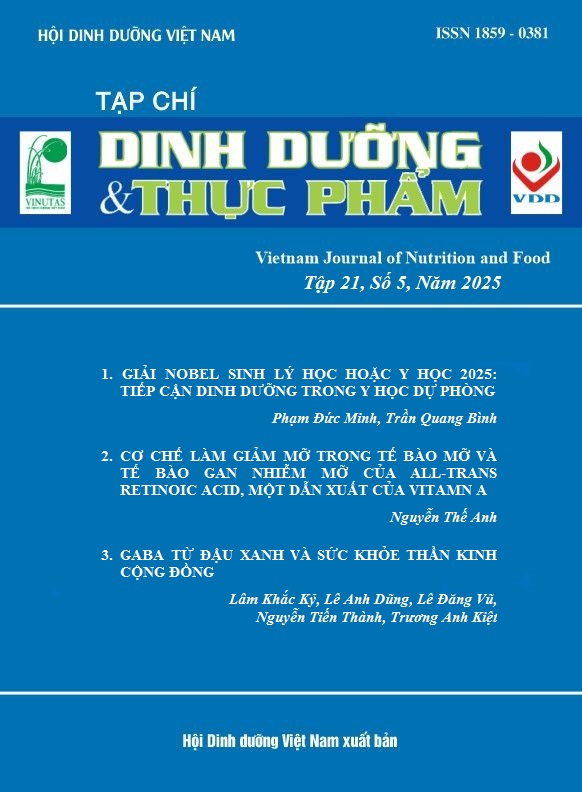KIẾN THỨC, THỰC HÀNH CHĂM SÓC CỦA NGƯỜI CHĂM SÓC TRẺ DƯỚI 5 TUỔI VÀ TÌNH TRẠNG AN NINH THỰC PHẨM HỘ GIA ĐÌNH TẠI 2 XÃ NGHÈO THUỘC HUYỆN SÌN HỒ, TỈNH LAI CHÂU NĂM 2023
Nội dung chính của bài viết
Tóm tắt
Mục tiêu: Mô tả kiến thức, thực hành chăm sóc trẻ của người chăm sóc và đánh giá tình trạng an ninh thực phẩm của hộ gia đình có trẻ dưới 5 tuổi tại 2 xã nghèo thuộc huyện Sìn Hồ, tỉnh Lai Châu năm 2023.
Phương pháp: Nghiên cứu mô tả cắt ngang được thực hiện trên 838 người chăm sóc trẻ dưới 5 tuổi tại 2 xã nghèo thuộc huyện Sìn Hồ, tỉnh Lai Châu. Dữ liệu về kiến thức, thực hành được thu thập và đánh giá theo khuyến cáo của WHO. Tình trạng ANTP hộ gia đình được đánh giá bằng thang đo HFIAS.
Kết quả: Kiến thức của người chăm sóc tương đối tốt (95,7% biết trên 5 nhóm thực phẩm ăn dặm...). Tỷ lệ thực hành chăm sóc trẻ đúng còn thấp. Chỉ 20,6% thực hành cho bú sớm và 12,3% trẻ (6-23 tháng) có chế độ ăn đa dạng tối thiểu. Tình trạng mất ANTP hộ gia đình nghiêm trọng, với 46,1% số hộ bị mất ANTP (trong đó 22,7% ở mức độ nặng). Các biểu hiện phổ biến gồm lo lắng thiếu thực phẩm (38,2%), thiếu tiền mua thức ăn ưa thích (31,5%), và nhịn đói đi ngủ (14,9%).
Kết luận: Tồn tại khoảng trống kiến thức-thực hành lớn trong nuôi dưỡng trẻ, liên quan chặt chẽ với mất ANTP. Mất ANTP là rào cản chính; cần can thiệp đồng thời giáo dục dinh dưỡng và hỗ trợ sinh kế để đảm bảo ANTP hộ gia đình.
Từ khóa
suy dinh dưỡng, trẻ em dưới 5 tuổi, kiến thức, thực hành, an ninh dinh dưỡng, an ninh thực phẩm
Chi tiết bài viết
Tài liệu tham khảo
2. Viện Dinh Dưỡng Quốc Gia, Tổng điều tra dinh dưỡng 2019-2020. 2021.
3. HelenKellerInternational-Vietnam, Mở rộng dự án Cải thiện Dinh dưỡng và An ninh thực phẩm - Thông qua tăng cường sản xuất thực phẩm tại hộ gia đình ở Việt Nam 2017 – 2021. 2021.
4. SaveChildren, Báo cáo tổng kết dự án: “Thúc đẩy các giải pháp thay thế nhằm cải thiện dinh dưỡng trẻ em và an ninh thực phẩm cho người nghèo có hoàn cảnh đặc biệt khó khăn” Hà Nội. 2016.
5. Kavle JA and Landry M. Addressing barriers to maternal nutrition in low‐and middle‐income countries: A review of the evidence and programme implications. Maternal & child nutrition, 2018. 14(1): p. e12508.
6. El Bilbeisi AH, et al. Households' food insecurity and their association with dietary intakes, nutrition-related knowledge, attitudes and practices among under-five children in Gaza Strip, Palestine. Frontiers in Public Health, 2022. 10: p. 808700.
7. FAO, The state of food security and nutrition in the world: Building climate resilience for food security and nutrition. Rome, Ytalia. 2018.
8. Farhadian A, et al. Addressing household food insecurity using the household food insecurity access scale (HFIAS) in a poor rural community in Sabah, Malaysia. International Journal of Humanities and Social Science Invention, 2015. 4(8): 89-100.
9. McDonald C, et al. Household food insecurity and dietary diversity as correlates of maternal and child undernutrition in rural Cambodia. European Journal of Clinical Nutrition, 2015. 69(2): 242-246.
10. Disha A, Purnima M, and Rahul R. Household food insecurity is associated with higher child undernutrition in Bangladesh, Ethiopia, and Vietnam, but the effect is not mediated by child dietary diversity. The Journal of nutrition, 2013. 143(12):2015-2021.
11. McDonald CM, et al. Correlates of household food insecurity and low dietary diversity in rural Cambodia. Asia Pacific journal of clinical nutrition, 2015. 24(4):720-730.
12. Nguyễn Viết Đăng, Lưu Văn Duy, Mạc Văn Vữ, An ninh thực phẩm của các hộ nghèo ở huyện Mai Châu, tỉnh Hòa Bình: thực trạng và giải pháp. Tạp chí Khoa học và Phát triển, 2014. 12: p. 821-828.
13. UNICEF, Thực trạng và xu hướng nghèo đa chiều trẻ em ở Việt Nam. 2021.
14. Lê Thế Trung, Hiệu quả mô hình sản xuất thức ăn bổ sung đến an ninh thực phẩm hộ gia đình và tình trạng dinh dưỡng trẻ <24 tháng tuổi tại 1 số tỉnh miền núi phía bắc. Luận án Tiến sĩ Dinh dưỡng - Viện Dinh Dưỡng Quốc Gia, 2022.
15. Viện Dinh Dưỡng Quốc Gia, Bảng báo cáo tỷ lệ suy dinh dưỡng trẻ em dưới 5 tuổi theo các mức độ, theo vùng sinh thái của công văn 1258/VDD-GSDD ngày 30/12/2021. 2021.
16. Thủ Tướng Chính Phủ, Quyết định số 353/QĐ-TTg phê duyệt danh sách huyện nghèo, xã đặc biệt khó khăn vùng bãi ngang, ven biển và hải đảo giai đoạn 2021-2025. 2022.
17. Saaka M, et al. Household food insecurity, coping strategies, and nutritional status of pregnant women in rural areas of Northern Ghana. Food science & nutrition, 2017. 5(6): 1154-1162.


